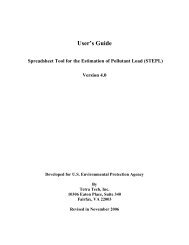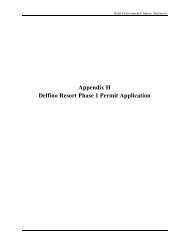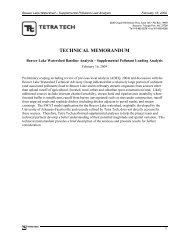SWAT Model Recalibration - Tetratech-ffx.com
SWAT Model Recalibration - Tetratech-ffx.com
SWAT Model Recalibration - Tetratech-ffx.com
- No tags were found...
Create successful ePaper yourself
Turn your PDF publications into a flip-book with our unique Google optimized e-Paper software.
Beaver Lake <strong>SWAT</strong> <strong>Model</strong>ing Baseline Analysis February 12, 20095 Comparison of Existing and 2055 ScenariosTetra Tech’s version of the <strong>SWAT</strong> model for the Beaver Lake watershed was used to <strong>com</strong>pare sedimentand nutrient loading under existing and future conditions. Loads generated in each of eight reportingwatersheds are <strong>com</strong>pared for sediment, total phosphorus, and total nitrogen.A <strong>com</strong>parison of the existing and future land use <strong>com</strong>position is shown in Figure 29. The pie chartclassifications aggregate rangeland into the forest category and show Bermuda and fescue together aspasture. The percent of land as forest/range land/brush in the watershed is expected to decrease from 70percent under current conditions to 60 percent under the future scenario. Agricultural areas will likelydecrease from 2 percent to 1 percent. The area currently in pasture is assumed to decrease from 21percent to 15 percent. Low density urban development increases from 2 percent to 18 percent, and highdensity urban development increases from 1 percent to 2 percent.Existing (2006)Future (2055)Urban/HighDensityLow Density 1%2%Pasture21%Agriculture2%Water4%Pasture15%Low Density18% Urban/HighDensity2%Agriculture1%Water4%Forest70%Forest60%Figure 29. Comparison of Existing and Future Land Use CompositionTable 14 shows the percent change in land use area from existing to future conditions. The acreage offorest/rangeland/brush decreases by 14 percent and the acreage of pastureland decreases by 31 percent.The acreage of land used for agricultural production decreases by 17 percent. The acreages of lowdensity and high density urban development increase by 909 percent and 137 percent, respectively.36





